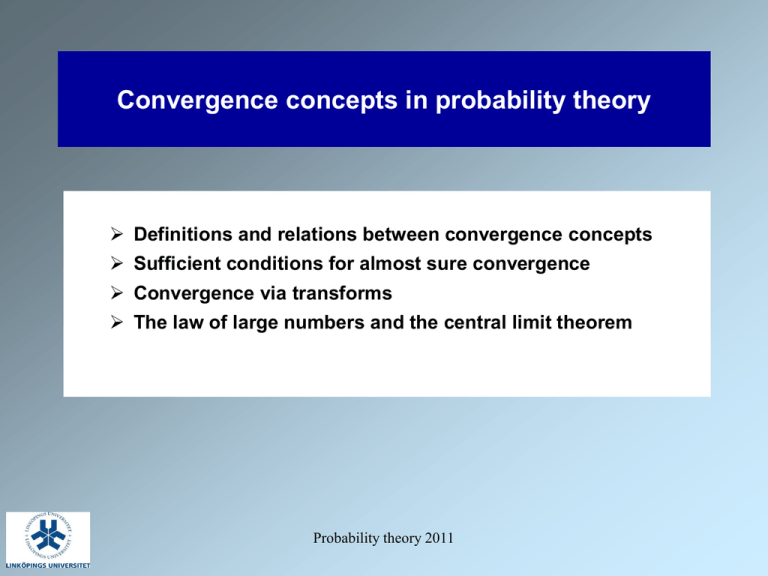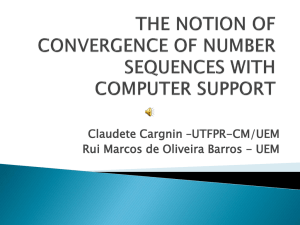X n
advertisement

Convergence concepts in probability theory
Definitions and relations between convergence concepts
Sufficient conditions for almost sure convergence
Convergence via transforms
The law of large numbers and the central limit theorem
Probability theory 2011
Coin-tossing: relative frequency of heads
1
0.9
Relative frequency of heads
0.8
0.7
Convergence of
each trajectory?
0.6
Series1
0.5
Series2
Series3
Convergence in
probability?
0.4
0.3
0.2
0.1
0
0
50
100
150
200
250
300
350
Probability theory 2011
400
Convergence to a constant
The sequence {Xn} of random variables converges almost
surely to the constant c if and only if
P({ ; Xn() c as n }) = 1
The sequence {Xn} of random variables converges in
probability to the constant c if and only if, for all > 0,
P({ ; | Xn() – c| > }) 0 as n
Probability theory 2011
An (artificial) example
Let X1, X2,… be a sequence of independent binary random variables such
that
P(Xn = 1) = 1/n and P(Xn = 0) = 1 – 1/n
Does Xn converge to 0 in probability?
Does Xn converge to 0 almost surely?
Common exception set?
Probability theory 2011
The law of large numbers for random variables
with finite variance
Let {Xn} be a sequence of independent and identically distributed random
variables with mean and variance 2, and set
Sn = X1 + … + Xn
Then
P(|
Sn
| ) 0 as n , for all 0
n
Proof: Assume that = 0. Then
.
P(|
Sn
| )
n
Var (
Sn
)
n
2
Probability theory 2011
Convergence to a random variable: definitions
The sequence {Xn} of random variables converges almost surely to the
random variable X if and only if
P({ ; Xn() X() as n }) = 1
Notation:
a. s .
X n
X as n
The sequence {Xn} of random variables converges in probability to the
random variable X if and only if, for all > 0,
P({ ; | Xn() – X()| > }) 0 as n
Notation:
Probability theory 2011
p
Xn
X as n
Convergence to a random variable: an example
Assume that the concentration of NO in air is continuously
recorded and let Xt, be the concentration at time t.
Consider the random variables:
Y max0t 1 X t
Yn max X 0 , X1/ n , X 2 / n , ... , X1
Does Yn converge to Y in probability?
Does Yn converge to Y almost surely?
Probability theory 2011
Convergence in distribution: an example
Let Xn Bin(n, c/n). Then the distribution of Xn converges to
a Po(c) distribution as n
Binomial and Poisson distributions (n = 20, c p== 0.1)
0.1)
0.30
Probability
0.25
0.20
Binomial
Poisson
0.15
0.10
0.05
.
0.00
0
1
2
3
4
5
6
7
Probability theory 2011
8
9
10
Convergence in distribution and in norm
The sequence Xn converges in distribution to the random variable X as
n iff
FX n ( x) FX ( x) as n
for all x where FX(x) is continuous.
Notation:
d
Xn
X as n
The sequence Xn converges in quadratic mean to the random variable X
as n iff
E | X n X |2 0 as n
Notation:
Probability theory 2011
2
Xn
X as n
Relations between the convergence concepts
Almost sure
convergence
Convergence
in probability
Convergence
in r-mean
Probability theory 2011
Convergence
in distribution
Convergence in probability implies
convergence in distribution
Note that, for all > 0,
P X n x
PX n x | X n X |
PX n x | X n X |
Probability theory 2011
Convergence almost surely convergence in r-mean
Consider a branching process in which the offspring distribution has mean 1.
Does it converge to zero almost surely?
Does it converge to zero in quadratic mean?
Let X1, X2,… be a sequence of independent random variables such that
P(Xn = n2) = 1/n2 and P(Xn = 0) = 1 – 1/n2
Does Xn converge to 0 in probability?
Does Xn converge to 0 almost surely?
Does Xn converge to 0 in quadratic mean?
Probability theory 2011
Relations between different types of
convergence to a constant
Almost sure
convergence
Convergence
in probability
Convergence
in r-mean
Probability theory 2011
Convergence
in distribution
Convergence via generating functions
Let X, X1, X2, … be a sequence of nonnegative, integervalued random variables, and suppose that
g X n (t ) g X (t ) as n
Then
d
Xn
X as n
Is the limit function of a sequence of
generating functions a generating
function?
Probability theory 2011
Convergence via moment generating functions
Let X, X1, X2, … be a sequence of random variables, and
suppose that
X (t ) X (t ) as n , for | t | h
n
Then
d
Xn
X as n
Is the limit function of a sequence of
moment generating functions a
moment generating function?
Probability theory 20101
Convergence via characteristic functions
Let X, X1, X2, … be a sequence of random variables, and
suppose that
X (t ) X (t ) as n , for t
n
Then
d
Xn
X as n
Is the limit function of a sequence of
characteristic functions a
characteristic function?
Probability theory 2011
Convergence to a constant
via characteristic functions
Let X1, X2, … be a sequence of random variables, and
suppose that
X (t ) eitc as n
n
Then
p
Xn
c as n
Probability theory 2011
The law of large numbers
(for variables with finite expectation)
Let {Xn} be a sequence of independent and identically
distributed random variables with expectation , and set
Sn = X1 + … + Xn
Then
Xn
.
Sn
p
as n
n
Probability theory 2011
The strong law of large numbers
(for variables with finite expectation)
Let {Xn} be a sequence of independent and identically
distributed random variables with expectation , and set
Sn = X1 + … + Xn
Then
Xn
.
S n a.s.
as n
n
Probability theory 2011
The central limit theorem
Let {Xn} be a sequence of independent and identically distributed random
variables with mean and variance 2, and set
Sn = X1 + … + Xn
Then
S n n d
N (0 ,1) as n
n
Proof: If = 0, we get
t
t t
t
S n (t ) S n ( ) X ( ) 1 o( )
n
n
n 2n
n
n
.
Probability theory 2011
2
2
n
Rate of convergence in the central limit theorem
E| X |3
sup x | FSn n ( x) ( x) | 0.7975 3
n
n
Example: XU(0,1)
.
E| X |3
1/ 4
8.3
0.7975 3
0.7975
n
1 /(12 12) n
n
Probability theory 2011
Sums of exponentially distributed random variables
gamma(10;1)
N(10;sqr(10))
0.14
1.20
0.12
1.00
Cumulative distribution function
Probability density
gamma(10;1)
0.10
0.08
0.06
0.04
0.02
N(10;sqr(10))
0.80
0.60
0.40
0.20
0.00
0.00
0
5
10
15
20
25
0
Probability theory 2011
5
10
15
20
25
Convergence of empirical distribution functions
# observatio ns x
Fn ( x)
n
d
n (Fn ( x) F ( x))
N (0, F ( x)(1 F ( x) )
Proof: Write Fn(x) as a sum of indicator functions
Bootstrap techniques: The original distribution is replaced with the empirical distribution
Probability theory 2011
Resampling techniques
- the bootstrap method
Resampled data
Observed data
62
90
22
41
34
67
88 79
39
73
58
x1* , x2* , ...60
, xN*
Sampling with
replacement
58
90 88 79
41
22
44
70 60
34
41
44
70 60
85
85
x
88
Probability theory 2011
x1* , x2* , ..., xN*
Characteristics of infinite sequences of events
Let {An, n = 1, 2, …} be a sequence of events, and define
A* lim infn An
A
m
n 1 m n
A lim sup n An
*
A
m
n 1 m n
Example: Consider a queueing system and let
An = {the queueing system is empty at time n}
Probability theory 2011
The probability that an event occurs infinitely often
- Borel-Cantelli’s first lemma
Let {An, n = 1, 2, …} be an arbitrary sequence of events. Then
P( A )
n 1
n
P( An i.o.) 0
Is the converse true?
Example: Consider a queueing system and let
An = {the queueing system is empty at time n}
Probability theory 2011
The probability that an event occurs infinitely often
- Borel-Cantelli’s second lemma
Let {An, n = 1, 2, …} be a sequence of independent events. Then
P( A )
n 1
n
P( An i.o.) 1
Probability theory 2011
Necessary and sufficient conditions for almost sure
convergence of independent random variables
Let X1, X2, … be a sequence of independent random variables. Then
a.s .
X n
0 as n
P(| X
n 1
Probability theory 2011
n
| )
Exercises: Chapter VI
6.1, 6.6, 6.9, 6.10, 6.17, 6.21, 6.25, 6.49
Probability theory 2011








